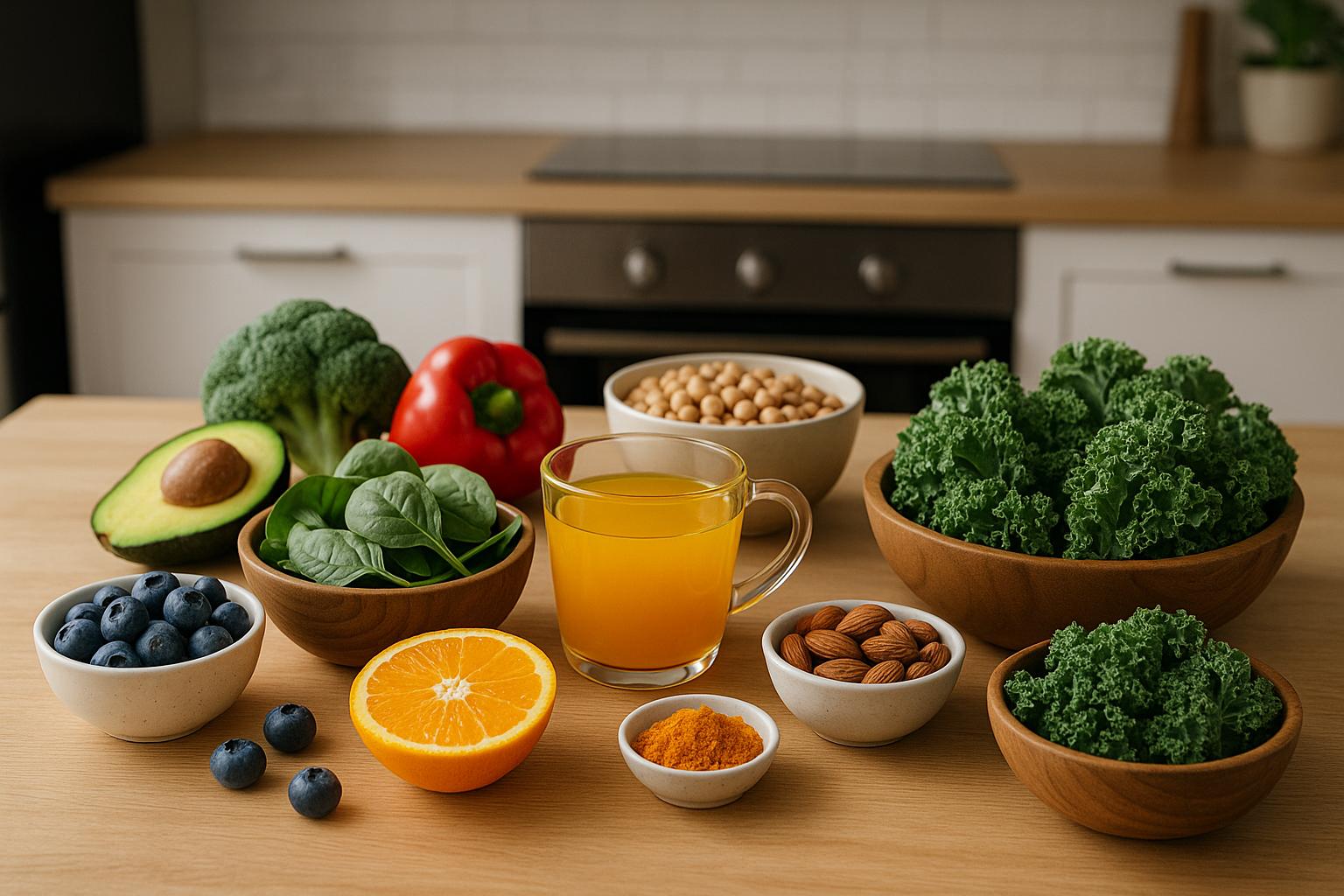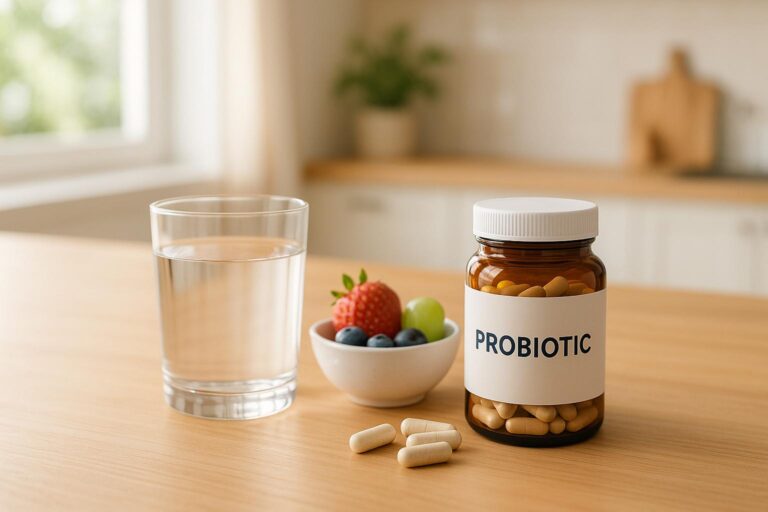Chronic pain affects nearly 70 million adults in the U.S., often linked to persistent, low-level inflammation. Research shows that what you eat can directly influence inflammation and pain levels. Anti-inflammatory diets focus on whole, nutrient-rich foods to reduce inflammation, improve gut health, and lower oxidative stress. Unlike medications, these diets address the root causes of pain without side effects.
Key Takeaways:
- Foods to Eat: Fatty fish, colorful fruits and vegetables, whole grains, nuts, and olive oil.
- Foods to Avoid: Processed meats, sugary drinks, refined carbs, and trans fats.
- Proven Benefits: Reduced pain levels, improved mobility, better sleep, and overall health.
Switching to an anti-inflammatory diet doesn’t have to be overwhelming. Start small by making gradual changes, like swapping refined grains for whole grains or using olive oil instead of butter. Pairing this diet with professional support and complementary therapies, such as those offered at clinics like Kinnection Clinic, can help you manage chronic pain more effectively.
Anti-inflammatory Diet for Pain Management
What Are Anti-Inflammatory Diets?
Anti-inflammatory diets emphasize eating whole, minimally processed, and diverse foods to help reduce inflammation. Nutrition researchers Alexander Scheiber and Victoria Mank describe this approach as:
"Anti-inflammatory diets are based on a holistic life approach with a dietary focus on whole foods that are biodiverse and not overly processed."
The idea is to lower inflammation by reducing pro-inflammatory markers in the body and improving metabolism. This approach stands in contrast to the typical Western diet, which is often loaded with processed meats, refined sugars, and unhealthy fats. Anti-inflammatory diets translate into straightforward guidelines that simplify making healthier food choices.
Basic Rules of Anti-Inflammatory Eating
The key to anti-inflammatory eating is prioritizing whole, unprocessed foods while cutting back on items that could fuel inflammation. Here’s how:
- Fruits and Vegetables: Make these the centerpiece of your meals. They’re packed with antioxidants and phytochemicals that fight inflammation.
- Whole Grains: Swap out refined grains for whole grains to boost fiber intake and support gut health.
- Healthy Fats: Replace butter with olive oil, which has been linked to lower inflammation.
- Protein Choices: Focus on fatty fish like salmon for omega-3s, limit red meat to once or twice a week, and include plant-based proteins like legumes for added fiber and nutrients.
- Cooking Methods: Choose baking, steaming, or stir-frying over grilling or deep-frying. For instance, grilling red meat can produce compounds linked to cancer.
Foods That Fight vs. Cause Inflammation
Certain foods are known for their anti-inflammatory properties, thanks to nutrients like omega-3 fatty acids, vitamin C, and polyphenols. Fatty fish such as salmon, mackerel, and sardines are rich in omega-3s, while brightly colored fruits and vegetables – like berries, leafy greens, bell peppers, and tomatoes – deliver antioxidants that combat harmful free radicals. Dr. Frank Hu, a Professor of Nutrition and Epidemiology at the Harvard School of Public Health, highlights:
"Many experimental studies have shown that components of foods or beverages may have anti-inflammatory effects."
On the flip side, some foods can contribute to inflammation. These include red and processed meats, refined carbs, sugary drinks, fried foods, and products with trans fats. Carefully reading food labels can help you avoid hidden sugars, trans fats, and heavily processed oils that might work against your goals.
Research-Backed Diet Plans
Several well-researched diets align with anti-inflammatory principles. The Mediterranean and DASH diets are prime examples. A 2021 study found that following the Mediterranean diet improved pain symptoms in older adults. This diet features plenty of fruits, vegetables, whole grains, olive oil, and fatty fish, while limiting processed foods and red meat.
Similarly, the DASH diet, originally designed to manage high blood pressure, focuses on fruits, vegetables, whole grains, lean proteins, and low-fat dairy, while cutting back on red meat, added sugars, and excess salt. Both diets share a common goal: prioritizing whole, nutrient-rich foods while avoiding inflammation-triggering ingredients. By adopting these eating patterns, you may not only reduce inflammation but also find relief from chronic pain.
How Anti-Inflammatory Diets Reduce Chronic Pain
There’s a strong connection between what we eat and how much pain we feel. Chronic pain affects 28.4% of adults in the United States – roughly 69.6 million people – making it a significant health issue. Research shows that changing dietary habits can noticeably ease this pain.
Research Results and Clinical Studies
The evidence supporting anti-inflammatory diets as a means to reduce pain is growing. Studies have linked chronic pain to oxidative stress, inflammation, and diet. For instance, a 2019 study gave participants with knee osteoarthritis 40 grams of freeze-dried blueberry powder daily for four months. Those who took the blueberry supplement reported less pain, reduced stiffness, and improved mobility compared to a placebo group. While inflammatory markers didn’t change significantly, participants experienced real, measurable relief.
Another study examined the effects of low-carbohydrate diets. In a randomized trial involving 21 participants with knee osteoarthritis, those on a low-carb diet experienced reduced pain during activities, lower self-reported pain levels, and decreased oxidative stress markers when compared to participants on low-fat diets or in control groups over 12 weeks.
The benefits of anti-inflammatory diets go beyond pain relief. A pilot study on individuals with chronic pain from rheumatic diseases found that eating more anti-inflammatory foods improved physical health, reduced stress, and lessened pain. Additionally, cutting back on pro-inflammatory foods was linked to better sleep quality.
These findings highlight the biological mechanisms that make these diets effective for managing chronic pain.
How These Diets Work in Your Body
Anti-inflammatory diets work by targeting key biological processes that contribute to chronic pain. Here are the three main ways they help:
1. Reducing Pro-inflammatory Cytokines
These diets help lower levels of pro-inflammatory markers in the body. Foods rich in omega-3 fatty acids, antioxidants, and polyphenols have been shown to reduce the activity of genes involved in inflammation and decrease circulating inflammatory markers [15, 19].
2. Improving Gut Health
A diet high in fiber and plant-based foods promotes a diverse and healthy gut microbiome. This helps prevent metabolic endotoxemia – a form of low-grade inflammation caused by toxins from the gut. Since gut health influences inflammation throughout the body, it plays a crucial role in managing chronic pain.
3. Reducing Oxidative Stress
Polyphenols and antioxidants found in fruits and vegetables combat oxidative stress, which can damage cells and trigger inflammation [28, 16]. This cellular protection helps prevent the chain reaction that leads to chronic pain.
Top Nutrients for Pain Relief
While a balanced diet is key, certain nutrients stand out for their pain-relieving benefits:
- Omega-3 Fatty Acids: Found in fatty fish like salmon and mackerel, as well as in flaxseeds, chia seeds, and walnuts, omega-3s are well-known for their anti-inflammatory properties.
- Antioxidants: These compounds help neutralize free radicals and protect cells from damage. Brightly colored fruits and vegetables like berries, leafy greens, and bell peppers are excellent sources.
- Fiber: Whole-food fiber supports a healthy gut microbiome and helps lower inflammation. It also reduces levels of C-reactive protein (CRP), a marker of inflammation, more effectively than supplements [19, 31].
- Polyphenols: These compounds, found in foods like extra virgin olive oil, tea, dark chocolate, nuts, and colorful fruits and vegetables, offer both anti-inflammatory and antioxidant benefits. They also improve blood pressure, regulate blood sugar, and support vascular health.
Harvard’s Dr. Frank Hu sums it up well:
"There is no super anti-inflammatory food or nutrient that you can just take and then you don’t have to worry about everything else in the diet. It has to be a holistic approach rather than a magic bullet approach."
Incorporating these nutrients into your meals can be a powerful way to manage chronic pain while supporting overall health.
sbb-itb-d9e542d
How to Start an Anti-Inflammatory Diet
Switching to an anti-inflammatory diet doesn’t have to be overwhelming. Take it step by step, keeping your lifestyle and budget in mind. Julia Zumpano, RD, LD, offers a helpful perspective:
"Drastic changes rarely yield lasting results, so give yourself three to six months to make diet changes and to begin to see results. Begin by making small changes that you know will be impactful, and then slowly continue to add on."
Creating Your Anti-Inflammatory Meal Plan
The key to success lies in planning meals with foods that are easy to find at your local grocery store. Liz Moore, a registered dietitian at Harvard-affiliated Beth Israel Deaconess Medical Center, advises starting small:
"Don’t try to suddenly switch to a new eating style. Start by slowly making changes so that these become more of a lifestyle shift rather than ‘going on a diet.’ Try to eat fewer foods that come from packages and more that come from the ground."
Here are some simple swaps to ease into the diet:
- Replace charcuterie boards with veggie slices and hummus.
- Swap French fries for baked sweet potatoes drizzled with olive oil and herbs.
- Use olive oil, vinegar, and herbs instead of butter- or cheese-based sauces.
- Try grilled eggplant or portobello mushrooms instead of traditional burgers.
- Choose dark chocolate with fresh raspberries or grilled peaches over bakery desserts.
When planning meals, focus on versatile ingredients that can work across multiple recipes. For example, a bag of spinach can be used in smoothies, salads, and stir-fries. Salmon fillets can be grilled one day, added to a salad the next, and turned into patties later in the week. This approach not only saves time and money but also ensures you always have anti-inflammatory options on hand.
Stock your pantry with staples like extra virgin olive oil, canned wild salmon, frozen berries, quinoa, brown rice, canned beans, walnuts, almonds, and spices like turmeric, ginger, and garlic. These basics make it easier to whip up healthy meals, even when fresh ingredients aren’t available.
Solving Common Diet Challenges
Adopting a new diet can come with its challenges, but a little preparation can go a long way.
Time Constraints
Busy schedules often get in the way of healthy eating. Set aside 2–3 hours on Sunday to prep for the week. Wash and chop vegetables, cook grains in bulk, and pre-cook proteins that can be reheated in minutes. Stick to recipes that take 20–30 minutes to prepare and use similar base ingredients.
Budget Concerns
Healthy eating doesn’t have to break the bank. Look for store brands and compare prices at different retailers – many now offer affordable organic and natural products. Plant-based proteins like lentils, chickpeas, and black beans are not only nutrient-rich but also cost-effective. For instance, a 1-pound bag of dried lentils costs about $2.00 and provides several servings.
Social Situations
Dining out can be tricky, but a little planning helps. Check restaurant menus beforehand and opt for dishes like grilled fish, salads with olive oil dressing, or vegetable-based sides. Don’t hesitate to ask for modifications, such as swapping butter for olive oil or requesting dressing on the side.
Taste Preferences
If you’re worried about flavor, spices and herbs can make all the difference. Turmeric, garlic, ginger, and cinnamon not only enhance taste but also offer anti-inflammatory benefits. Start with small amounts and adjust as you get used to the flavors.
Getting Professional Nutrition Help
While general tips are a good starting point, a personalized nutrition plan can make a big difference in managing chronic pain through diet. Julia Zumpano explains:
"The term ‘anti-inflammatory diet’ doesn’t refer to a specific diet regimen but to an overall style of eating",
This means your plan should align with your health needs, food preferences, and lifestyle.
If you have multiple health conditions or medications that could interact with certain foods, consulting a professional is essential. A qualified nutritionist can help identify your personal inflammatory triggers – often through elimination diets – and create meal plans tailored to your challenges.
The Kinnection Clinic takes a comprehensive approach by combining nutritional counseling with treatments like chiropractic care and regenerative medicine. This method addresses the root causes of chronic pain while creating a plan that fits your eating habits, cooking skills, budget, and health goals. With their guidance, you can make the transition smoother and achieve long-term success in managing chronic pain through diet.
Functional Medicine for Chronic Pain Management
Building on the benefits of anti-inflammatory eating, functional medicine offers a broader, more personalized approach to tackling chronic pain. By focusing on the root causes of discomfort, this method goes beyond symptom management to address the underlying issues that fuel pain.
Functional Medicine Approach to Pain
Functional medicine takes a unique perspective on chronic pain, treating it as part of a larger, interconnected system rather than an isolated issue. Dr. Henri Roca, MD, emphasizes this holistic view:
"So I have to see the whole person. I have to get to the root cause. I have to honor their life story, and I have to use everything that works to help bring the person to their best place of health."
This approach involves creating a detailed timeline of your symptoms, identifying specific triggers, and using advanced testing to uncover hidden contributors to pain. These may include autoimmunity, gut issues, hormone imbalances, toxin exposure, nutrient deficiencies, metabolic conditions, genetic predispositions, or food sensitivities. By addressing these factors, functional medicine practitioners can develop a tailored plan that complements dietary changes, such as anti-inflammatory eating.
Dr. Hong Shen, a specialist in pain management, highlights the impact of this integrated approach:
"I’ve found that incorporating functional medicine’s integrative approach into an overall treatment plan can greatly improve a patient’s response to treatment."
Lifestyle factors also play a significant role. Dr. Elizabeth Bradley, Medical Director of the Center for Functional Medicine at Cleveland Clinic, explains:
"If a person with chronic pain is not sleeping or eating well, pain medication and other treatments will only do so much."
Functional medicine practitioners often recommend specific diets, such as anti-inflammatory, low-glycemic, gluten-free, or low-grain plans, to support mitochondrial health. These cellular powerhouses are often damaged in chronic pain conditions. Alongside dietary changes, exercise programs can help by increasing mitochondrial function, improving respiratory capacity, and reducing harmful reactive oxygen species (ROS).
This thorough evaluation allows practitioners to create targeted treatments that work hand-in-hand with dietary strategies.
Complete Care at Kinnection Clinic

Kinnection Clinic takes these principles and applies them through comprehensive, personalized care. Instead of treating anti-inflammatory diets as a standalone solution, the clinic combines them with other therapies to address pain from multiple angles.
Their approach includes Gonstead chiropractic care, IV therapy, and regenerative medicine, all designed to enhance pain relief and support the body’s natural healing processes. For instance, pairing anti-inflammatory diets with chiropractic care can help reduce inflammation, strengthen the spine and joints, and speed up recovery.
IV therapy provides immediate delivery of anti-inflammatory nutrients, bridging the gap while dietary changes take effect. Regenerative medicine techniques, such as PRP (platelet-rich plasma) therapy and peptides, work alongside proper nutrition to promote tissue healing and repair at the cellular level.
Another critical aspect is hormone replacement therapy, which addresses hormonal imbalances that can contribute to inflammation and heightened pain sensitivity. By optimizing hormone levels, patients often experience better results from their dietary interventions.
Functional medicine consultations at Kinnection Clinic include advanced testing to uncover hidden causes of chronic pain. For example, if poor gut health is driving inflammation, the treatment plan might include anti-inflammatory foods that support intestinal healing, supplements to restore gut bacteria, and IV therapy for immediate nutritional support.
Additionally, the clinic offers performance coaching and mindset training to address the psychological effects of chronic pain. Stress, poor sleep, and mental health challenges can hinder recovery, making this component vital for long-term success.
This integrative approach reduces reliance on medications that may have side effects or lead to dependency. By combining anti-inflammatory nutrition with therapies like chiropractic care, regenerative medicine, and hormone optimization, patients can achieve meaningful pain relief and improved well-being.
What sets this approach apart is its focus on personalization. While general guidelines for anti-inflammatory diets are helpful, Kinnection Clinic ensures that each plan is tailored to the individual. By addressing specific inflammatory triggers and health conditions, the clinic creates an environment that promotes lasting pain relief and overall wellness.
Main Points for Reducing Pain Through Diet
An anti-inflammatory diet can play a key role in managing chronic pain by addressing persistent inflammation. The foods you choose daily have a direct impact on your body’s inflammatory response and, ultimately, your pain levels.
To support this approach, focus on nutrient-rich foods. Aim to include 3–4 ounces of fatty fish twice a week, 1½–2 cups of fruit and 2–3 cups of vegetables per meal, a daily handful (1.5 ounces) of nuts, and 2–3 tablespoons of olive oil. These foods are packed with omega-3 fatty acids, antioxidants, and polyphenols, which are known to help lower inflammation. By prioritizing these choices, you set a strong foundation for measurable pain relief.
Equally important is avoiding foods that promote inflammation. Ultra-processed items, refined carbohydrates, sugary drinks, and processed meats can raise inflammatory markers in the body. As Eric Rimm, professor of epidemiology and nutrition at Harvard T.H. Chan School of Public Health, points out:
"The diet in general is almost as much about what you don’t eat as what you do eat".
The Mediterranean diet is a prime example of this balance. Research has shown it can significantly reduce pain for individuals with conditions like osteoarthritis and rheumatoid arthritis.
Seeking professional guidance can amplify these benefits. Katlyn Cusack MS, RDN, LDN, a registered dietitian at Hackensack Meridian Health, emphasizes:
"One of the best ways to reduce pain lies not in your medicine cabinet, but in your refrigerator. By following an anti-inflammatory diet, you can help fight off inflammation in your body and reduce chronic pain".
Chronic pain impacts about 20% of adults worldwide, with older adults particularly vulnerable. Up to 50% of them face an increased risk of malnutrition. Personalized support, such as that offered at Kinnection Clinic, can help fine-tune dietary strategies for better results.
At Kinnection Clinic, patients benefit from customized nutrition plans that integrate functional medicine and complementary therapies. These plans are tailored to address individual inflammatory triggers, food sensitivities, and underlying health issues. This holistic approach also tackles poor dietary habits, a leading modifiable factor linked to higher mortality rates.
Finding relief through diet takes time and commitment. Dr. Fred Tabung, a visiting researcher at Harvard’s T.H. Chan School of Public Health, reminds us:
"Your diet is not a quick-fix pill, but it has high potential to help manage and even prevent inflammation, which can help soothe chronic pain".
FAQs
How long does it take to feel pain relief from an anti-inflammatory diet?
Many individuals begin to see a reduction in pain within 3 to 6 months of sticking to an anti-inflammatory diet. That said, the timeline can differ depending on factors like the level of inflammation, overall health, and how closely the diet is followed.
To maximize results, prioritize nutrient-dense, whole foods such as fruits, vegetables, healthy fats, and lean proteins. At the same time, steer clear of processed foods, added sugars, and trans fats. Staying consistent and patient is crucial for achieving long-term benefits.
What are the best anti-inflammatory foods to help reduce pain from arthritis and other chronic conditions?
Certain anti-inflammatory foods can help ease pain and inflammation linked to conditions like arthritis. Adding options such as leafy greens (like spinach and kale), fatty fish (such as salmon and sardines), berries, nuts, seeds, olive oil, and green tea to your meals might make a difference in managing chronic pain.
These foods are packed with antioxidants, omega-3 fatty acids, and other nutrients that work to reduce inflammation, support joint health, and ease discomfort. Incorporating them into your diet regularly is a straightforward and natural way to encourage better long-term comfort and overall wellness.
How can I stick to an anti-inflammatory diet when eating out or attending social events?
Maintaining an anti-inflammatory diet while dining out or attending social gatherings doesn’t have to be complicated. Start by choosing grilled proteins like chicken or fish, and fill your plate with vegetables and whole grains rather than processed or fried foods. When it comes to drinks, skip the sugary options and go for water, herbal tea, or other unsweetened beverages.
If you’re heading to a restaurant, take a moment to check the menu online beforehand. Look for dishes that fit your dietary goals, and don’t be shy about requesting adjustments – like swapping fries for extra veggies or asking for sauces on the side. With a little planning and thoughtful decisions, you can enjoy eating out while sticking to your anti-inflammatory goals.



